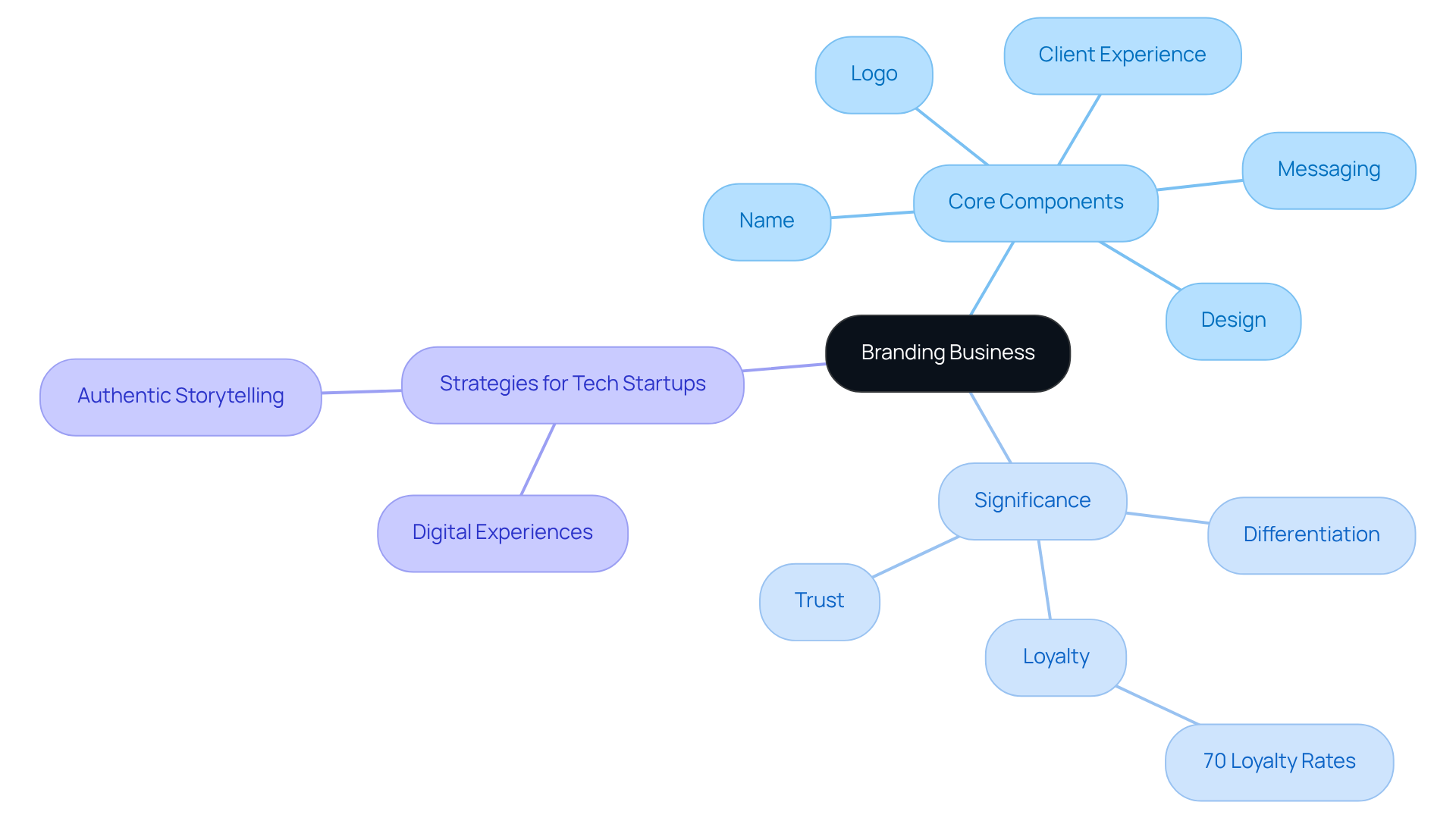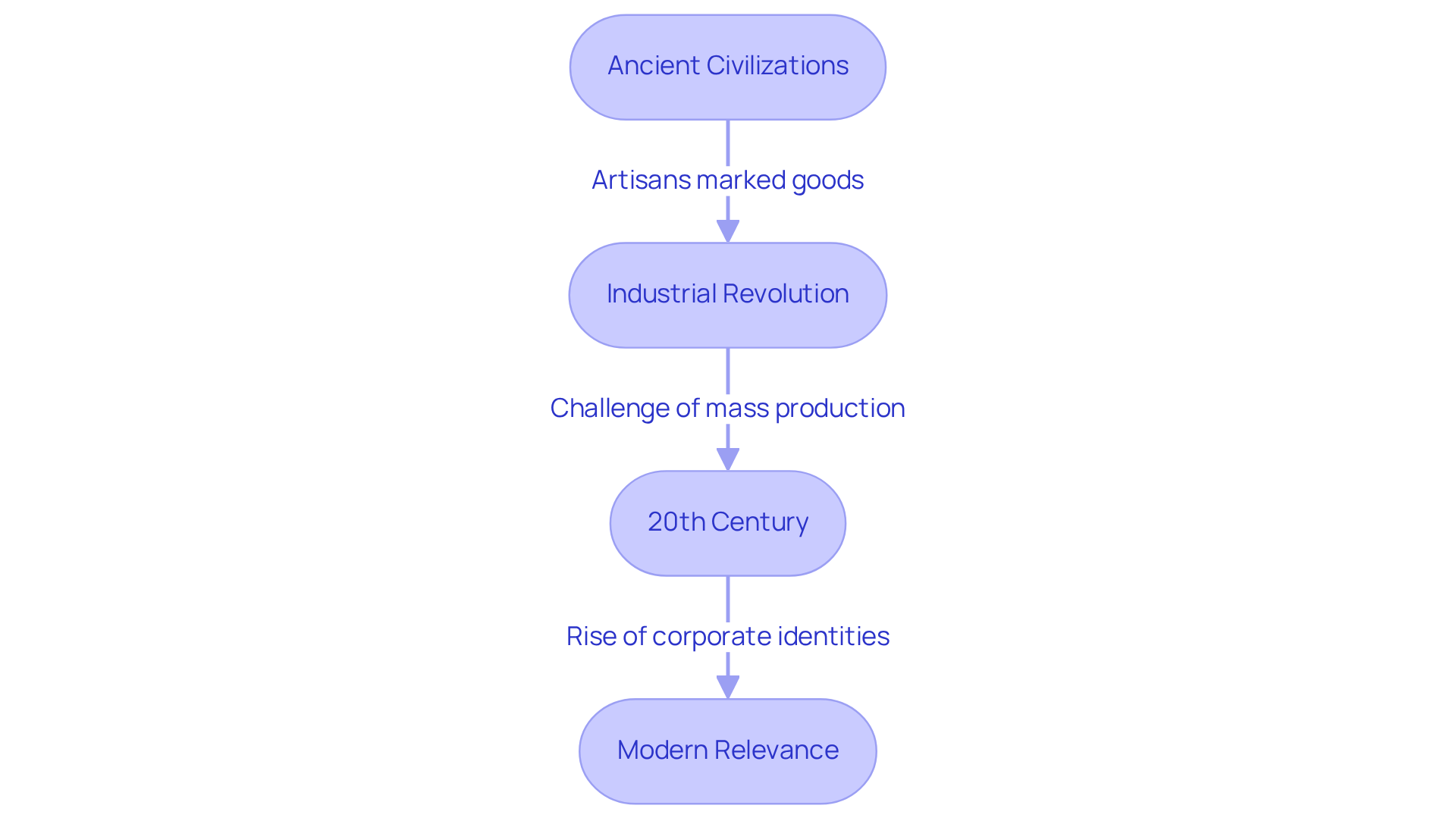Overview
Branding a business can feel like a daunting challenge, especially when trying to carve out a unique identity in the competitive landscape of tech startups. Many founders grapple with the overwhelming pressure to stand out and connect with consumers on a deeper level. This struggle is not just about aesthetics; it’s about fostering loyalty and trust, which are vital for long-term success.
A strong brand identity, encompassing elements such as your name, logo, and messaging, plays a crucial role in differentiating your company. It’s heartening to know that effective branding can significantly impact customer retention and trust. Studies show that businesses with a compelling brand identity can enjoy loyalty rates as high as 70%. This statistic underscores the importance of nurturing a brand that resonates emotionally with your audience.
At RNO1, we understand the emotional journey of tech startup founders. We believe that every brand has a story waiting to be told, and we’re here to help you share yours. By focusing on creating a unique brand identity, you can not only attract customers but also build lasting relationships with them. Let’s work together to transform your vision into a brand that not only stands out but also fosters loyalty and trust among your customers.
Introduction
Branding is not just a task; it’s a profound journey that shapes your business's identity in an increasingly crowded marketplace. For tech startups, the challenge of standing out can feel overwhelming. It’s easy to feel lost amid the noise. Yet, by understanding the core elements of branding—like messaging, design, and customer experience—you can unlock significant opportunities for connection and loyalty.
How can you, as founders, navigate the complexities of branding to create a narrative that resonates deeply with your audience and fosters lasting relationships? This exploration delves into the essential concepts and importance of branding in modern business, revealing strategies that can transform perception and drive success.
Together, let’s uncover how to make your brand not just seen, but truly felt.
Define Branding Business: Core Concepts and Significance
Branding a business involves more than just a task; it’s a heartfelt journey towards creating a with your audience. Many tech startup founders struggle with this challenge, feeling overwhelmed by the need to stand out in a crowded marketplace. The components of branding—such as name, logo, design, messaging, and client experience—can feel daunting. Yet, it’s crucial to understand that ; it serves as a vital tool for differentiation, fostering loyalty and trust among clients.
In 2025, studies show that , with strong brand identities linked to loyalty rates as high as 70%. As Jeff Bezos wisely notes, ',' underscoring how perception shapes loyalty. It's essential to recognize that a , enhancing both value and recognition.
For tech startups, often involve harnessing innovative digital experiences and authentic storytelling to engage audiences meaningfully. As Bastien Frediani points out, 'Most individuals can develop a service or product, but only committed and resolute business leaders understand how to establish a successful identity.' This insight highlights the importance of focusing on a strong identity.
RNO1’s , including Revolve, Retrn, and Ryde, empower companies by offering ongoing support and expertise. This contemporary approach to identity nurtures , reinforcing the notion that a company’s strength lies in its ability to create lasting impressions. In today’s , this is not just beneficial; it’s essential.

Trace the Evolution of Branding: Historical Context and Modern Relevance
Branding has undergone a remarkable transformation since its beginnings in ancient civilizations, where artisans marked their goods not just for ownership, but to signify quality. This practice speaks to a fundamental human need for identity and assurance. However, as we moved into the Industrial Revolution, a significant challenge arose: mass production created an overwhelming marketplace, making it difficult for products to stand out. This need for differentiation became a pressing concern for many, especially for those striving to establish their own ventures.
In the 20th century, the landscape shifted again. Product identity became intertwined with marketing, with iconic companies like Coca-Cola and Nike crafting powerful that resonated with consumers. Yet, this evolution also brought about new pressures. How can a startup founder ensure their brand is not just seen, but truly felt by their audience? This question weighs heavily on many.
Today, holds more significance than ever. have opened up direct lines of communication with customers, making authenticity and purpose-driven identity essential for success in a competitive environment. It’s a daunting reality, but there is hope. By embracing the principles of and shared values, can cultivate a brand that not only stands out but also resonates deeply with their audience. Together, we can , ensuring that your brand reflects the true essence of your mission and vision.

Identify Key Components of Branding: Elements That Shape Business Identity
In the world of branding, many founders grapple with the challenge of . Essential elements such as the name, logo, color scheme, typography, messaging, and are crucial in shaping how consumers perceive their brand. A well-designed logo can be a powerful tool for immediate recognition; research indicates that a remarkable 75% of individuals can identify a company solely by its logo. This statistic highlights the that resonates with your audience.
Moreover, not only fortifies your brand's identity but can enhance recognition by up to 80%. This consistency is vital for conveying the right message and emotional appeal, allowing your brand to connect more deeply with consumers. The tone of voice in your messaging can evoke specific emotions, fostering a meaningful connection with your target audience.
Together, these create a that resonates with consumers, nurtures loyalty, and drives business success. For instance, companies that maintain a consistent presentation across various platforms can see revenue increases of up to 23%. This statistic serves as a reminder of the significance of and identity elements in establishing a strong market presence.
Furthermore, insights from 77% of marketing leaders affirm that , emphasizing the need for thoughtful investment in . As industry expert Manisha Saini wisely states, 'Logos are not just visual elements—they are powerful tools that shape consumer perceptions and influence purchasing decisions.' This further underscores the critical role that logos play in branding.
By acknowledging these elements and their impact, you can but also connects with your audience on a deeper level. Remember, your branding journey is not just about visuals; it's about creating a narrative that resonates, nurtures, and inspires.

Highlight the Importance of Branding: Impact on Business Success and Growth
The presents a significant challenge for many companies, as it is crucial for success in today’s competitive landscape. Without a , companies find it difficult to gain recognition, establish trust, and foster client loyalty. This can leave consumers feeling overwhelmed, making it difficult for them to make informed choices.
For instance, think about how Apple and Amazon have cultivated a through their thoughtful marketing strategies. Their success not only leads to ongoing expansion and profitability but also illustrates the . In fact, studies indicate that 57% of consumers are willing to invest more in companies they trust, underscoring the economic benefits of a .
Moreover, effective branding business goes beyond just market share; it drives higher sales and enhances customer retention, ultimately paving the way for . Case studies further reveal that companies with strong brands attract more job applicants and enjoy higher employee engagement, which correlates with increased productivity and lower turnover rates.
This multifaceted influence of brand identity highlights its and maintaining a in today's dynamic branding business environment. Together, we can navigate these challenges and embrace the .

Explore Current Branding Trends: Adapting to the Digital Landscape
In today's world, many consumers feel a deep need for authenticity and connection with the brands they support. They are increasingly searching for companies that not only share their values but also demonstrate a . This desire for alignment can be challenging for businesses, especially as the landscape evolves. It’s essential to recognize that when consumers feel their values are reflected in a brand, it .
As we look ahead to 2025, the rise of . Companies must engage their audiences through . This is where technology, such as , comes into play. By embracing these tools, businesses can create memorable brand interactions that resonate deeply with their audience.
By staying attuned to these trends and actively engaging with consumers in meaningful ways, businesses can not only but also maintain a competitive edge. Together, we can navigate this evolving landscape, ensuring that your brand not only meets but of today's conscientious consumers.

Conclusion
Branding is not just a process; it is a transformative journey that establishes a distinct identity capable of resonating deeply with consumers. As the landscape evolves, particularly for tech startups, understanding the nuances of branding is essential for standing out in a competitive marketplace. The significance of brand identity goes beyond visual elements; it serves as a vital foundation for building trust, loyalty, and long-term relationships with clients.
Many founders face the challenge of crafting a brand that truly reflects their mission. This struggle can lead to feelings of frustration and uncertainty, especially when trying to connect with an audience that values authenticity and social responsibility. Throughout this article, we have explored key concepts such as the historical evolution of branding, the importance of consistent branding elements, and the modern trends shaping consumer expectations. From the origins of branding in ancient times to today's demands for genuine engagement, the insights underscore that a well-crafted brand identity can lead to increased customer retention, higher sales, and a stronger market presence. The emphasis on storytelling and innovative digital experiences highlights how brands can create emotional connections that drive loyalty.
In a world where consumers are increasingly drawn to brands that align with their values, the call to action is clear: invest in developing a strong brand identity that reflects the essence of your mission and vision. Embrace the evolving landscape of branding by leveraging technology and authentic engagement to foster meaningful connections. By doing so, you not only enhance your competitive edge but also contribute to a marketplace where trust and loyalty thrive. Remember, you are not alone on this journey—embracing these principles can lead to a fulfilling and successful branding experience.
Frequently Asked Questions
What is branding a business?
Branding a business involves creating a unique identity that resonates with your audience, encompassing elements such as name, logo, design, messaging, and client experience. It serves as a vital tool for differentiation and fosters loyalty and trust among clients.
Why is brand identity important for customer retention?
Effective branding significantly boosts customer retention, with strong brand identities linked to loyalty rates as high as 70%. A compelling narrative that connects emotionally with consumers enhances both value and recognition.
What strategies can tech startups use for successful branding?
Tech startups can harness innovative digital experiences and authentic storytelling to engage audiences meaningfully and establish a strong brand identity.
How has branding evolved over time?
Branding has transformed from artisans marking goods in ancient civilizations for quality assurance to a complex identity intertwined with marketing in the 20th century, exemplified by iconic companies like Coca-Cola and Nike. Today, authenticity and purpose-driven identity are essential for success in a competitive digital landscape.
What role do digital platforms play in modern branding?
Digital platforms provide direct lines of communication with customers, making it essential for brands to adopt authentic and purpose-driven identities to stand out in a crowded marketplace.
What is the significance of emotional connection in branding?
A compelling narrative that emotionally connects with consumers enhances brand value and recognition, making it crucial for startups to focus on creating a brand that resonates deeply with their audience.
How can companies create lasting impressions through branding?
Companies can create lasting impressions by nurturing long-term relationships with their audience through innovative branding strategies, such as unique subscription models that offer ongoing support and expertise.




